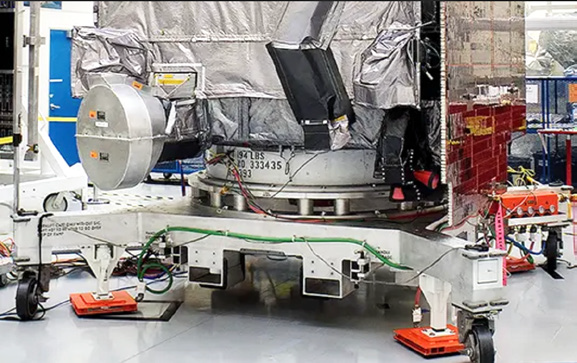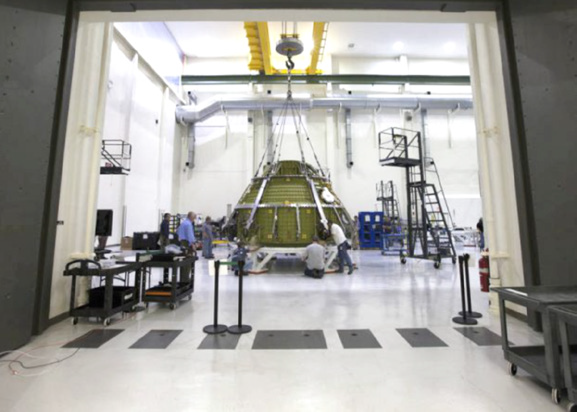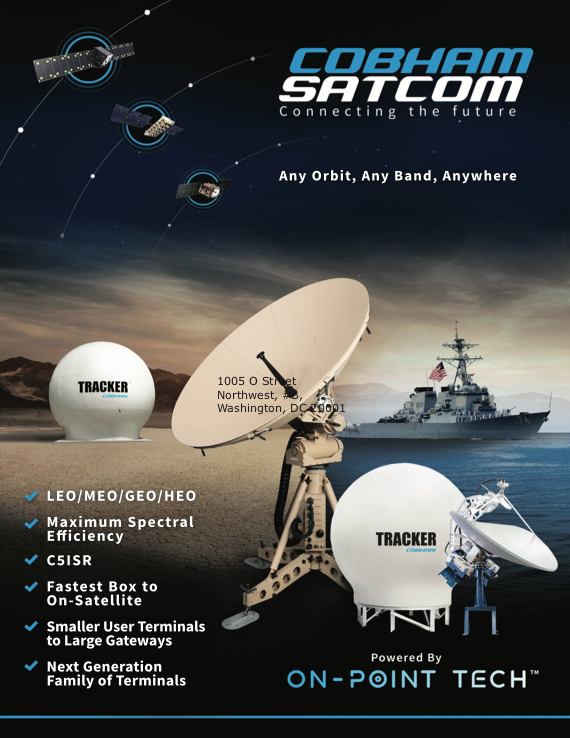Fifty years ago, the final Apollo space mission departed the moon’s surface and carried away the last two humans to ever set foot on the lunar surface, Gene Cernan and Harrison Schmitt. Now, the U.S. National Aeronautics and Space Administration (NASA) is working hard to bring humanity back to the moon through the agency’s multi-year, multi-stage, Artemis project. Working in cooperation with the European Space Agency (ESA), Japan Aerospace Exploration Agency (JAXA), and Canadian Space Agency (CSA), NASA and its partners have ambitious plans to build a permanent base camp on the moon.
 AeroGo Air Caster rigging system.
AeroGo Air Caster rigging system.
As part of that effort, they are building an array of brand-new, modern-age space vehicles, including the Space Launch System (SLS), Orion crew spacecraft, the Lunar Gateway space station, and Human Landing Systems. Getting Artemis and its component parts off the ground is obviously no small endeavor. Surprisingly, however, some of the most important moves for the estimated $93 billion project may well be those that have already happened on the ground before launch. That’s because building those vehicles requires an enormous amount of painstaking construction, testing, and preparation.
To complicate matters, moving multi-ton, delicate structures through the different stages of their terrestrial lifecycle is easier said than done. Traditional material handling solutions, such as cranes or transfer carts, can struggle with the weight of their payloads or risk the safety or integrity of the spacecraft, the facility, and workers. So, how do space agencies such as NASA solve these challenges? Simple: before they launch into space, they float on air.
Air Casters In The Artemis Project
The Orion crew capsules, part of a long-running collaboration between Lockheed Martin and NASA, perfectly illustrate the power of moving space vehicles on air. The Orion capsules are designed to support future missions not only to the moon but also to the International Space Station and beyond. “During Artemis I, the spacecraft will launch on the most powerful rocket in the world and fly farther than any spacecraft built for humans has ever flown,” wrote NASA in an announcement at the formal transfer of the Orion spacecraft for the Artemis I mission from Lockheed Martin. To move the Orion crew capsules safely, efficiently, and cost-effectively through construction and testing processes, engineers mounted them on substructures to which they then attached air casters.
Also known as air bearings or air pads, air casters are donut-shaped airbags that users inflate with compressed air. As the bag fills, it creates a seal with the floor into which excess air continuously seeps. That excess air creates a nearly frictionless, ultra-thin film of air less than .005” thick, upon which the payload (the Orion craft) literally floats, much like a hovercraft. That means operators can move even massive payloads by exerting only 1/10th of the force that would be required to move an equivalent load on wheeled casters. With the Orion craft, operators didn’t even need special training to use the air casters. They simply used standard shop air to inflate them and then pushed the payloads to their positions.
Air Casters Keep Both Payloads + People Safe and Sound
Air casters offer some significant advantages over alternative material handling solutions for aerospace applications, which is why they were already being used as far back as the Apollo VII missions. Then, they were similarly used to move the Apollo VII command module and other components around the Kennedy Space Center. Their proven utility has kept space agencies and aerospace contractors coming back to them over and over again.
For example, they help to protect surprisingly delicate aerospace components whose sheer expense makes any risk of damage untenable. Conventional wheels or rollers, for example, will unavoidably transmit vibrations and shock loads up the structure into the payload itself, potentially damaging or de-calibrating internal components. With air casters, the payload is essentially riding on an airbag that isolates the structure from any vibration or shock loads.
Even better, that protection works in two directions. Most aerospace facilities use floors treated with special (and expensive) epoxy coatings that dampen static electric and are easy to keep clean to prevent contamination. As a result, the floor itself is often a costly asset that requires protection.
Unfortunately, any material handling system that touches the floors risks damaging them. That’s especially true for wheeled casters, which concentrate the weight of payload — potentially hundreds or thousands of pounds per square inch (psi) of pressure — at tiny points of contact. Even if these pressures don’t outright crack or break the floor surface, they can risk scraping, gouging, or having a sandpaper-like effect on the floor surface.
 Orion pressure vessel testing.
Orion pressure vessel testing.
By contrast, as air casters literally float the load above the floor and reduce the pressure exerted on the floor to around 20 to 50 psi, they virtually eliminate the potential for floor damage. Similarly, air casters can keep these facilities clean of foreign object debris or volatile organic compounds — either of which could potentially foul the internal components of aerospace vehicles — that can result from the use of mechanical material handling systems. That’s particularly important in fueling areas, where operators need a solution that produces no sparking and is inherently explosion proof.
The Sky’s The Limit For Air Caster Flexibility
Unlike almost any other material handling system capable of moving large loads, air casters can fit basically anywhere. The payload doesn’t have to fall within the reach of a crane and can be moved easily between rooms and even buildings in a single go. The payload can be maneuvered through hallways barely wider than the load itself, while fitting into tight corners and making sharp 90-degree turns.
As air casters have a minimal footprint, can move omni-directionally, and can turn within their own radius, they enable much greater flexibility and adaptability, especially when compared to something such as a crane, which is a fixed monument that has a fixed work envelope. That kind of flexibility has been a major boon for the Artemis project to maintain cost-effectiveness and speed. The Orion modules, for example, were partly constructed in a facility purpose-built to be changed around on the fly, including portable cleanrooms.
Air casters allowed them to move entire workstations at need. This flexibility is extremely important if the facility is going to be used to house or work on different kinds of aerospace equipment or structures, given that the Artemis project includes so many kinds of components. This becomes a major advantage to use a material handling system that can be adapted and configured to handle a whole range of weights, sizes, and shapes and potentially move them almost anywhere within the facility.

Making Material Handling Challenges Disappear Into Thin Air Isn’t Rocket Science
For decades, air casters have been a staple for aerospace agencies and their contractors, including NASA, ESA, Lockheed Martin, Boeing, and others because they move heavy, precious payloads with minimal disruption. Handling these structures while still on the Earth requires a strict, painstaking process that can protect the payloads, the facility, and the people working on them, while still enabling precision positioning and quick, easy mobility. Many of the most important moves happen long before these space vehicles ever reach orbit.
No wonder that the ambitious Artemis project is making use of air caster technology, on its own or in conjunction with other solutions such as cranes, to enable safe transport of virtually unlimited load sizes and shapes. In short, when NASA and other space agencies shoot for the stars, they first turn to a solution that can float on air.
www.aerogo.com

Author Devin Chandler, BSME. is a sales engineer in the Custom Products Group at AeroGo, Inc. Founded in 1967, AeroGo is the world leader in providing innovative load moving solutions for awkward, delicate, or exceptionally heavy loads used in fa the world leader in providing innovative load moving solut awkward, delicate, or exceptionally heavy loads used in factories.


